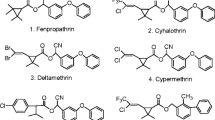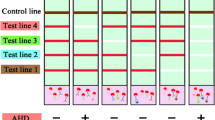Abstract
Permethrin is the most popular synthetic pyrethroid insecticide used in agriculture and public health. For the assessment of human exposure to permethrin, a competitive indirect enzyme-linked immunosorbent assay (ELISA) for the detection of the glycine conjugate of a major metabolite, cis-/trans-3-(2,2-dichlorovinyl)-2,2-dimethylcyclopropane-1-carboxylic acid (DCCA), of permethrin was developed based on a polyclonal antibody. An assay based on an antibody with a high sensitivity was optimized and characterized. The IC50 value and the detection range for trans-DCCA–glycine, in the assay buffer were 1.2 and 0.2−7.0 μg/L, respectively. The antibody recognized trans-DCCA–glycine and the mixture of cis-/trans-DCCA–glycine with an isomer range from 30:70 to 50:50 nearly equally. Little or no cross-reactivity to permethrin and its other free metabolites or glycine conjugates was measured. The integration of the ELISA and solid-phase extraction which was used to reduce the matrix effect from human urine samples provided for analysis of total cis-/trans-DCCA–glycine at low parts per billion levels in the samples. The limit of quantitation of the target analyte was 1.0 μg/L in urine with a limit of detection of 0.1 μg/L in buffer. This assay might be a useful tool for monitoring human exposure to permethrin.





Similar content being viewed by others
References
Gianessi LP, Silvers CS (2001) Trends in crop pesticide use: comparing 1992 and 1997. Florida Agricultural Statistics Service, United States Department of Agriculture., July
Department of Pesticide Regulation (2003) Study 219: monitoring surface waters and sediments of the Salinas and San Joaquin river basins for synthetic pyrethroid pesticides. Department of Pesticide Regulation Environmental Monitoring Branch, Sacramento, CA
Hervé JJ (1985) In: Leahey JP (ed) The pyrethroid insecticides. Taylor and Francis, London, pp 343–425
Casida JE, Ruzo LO (1980) Pestic Sci 11:257–269
Miyamoto J, Beynon KI, Roberts TR, Hemingway RJ, Swaine H (1981) Pure Appl Chem 53:1967–2022
Schulz J, Schmoldt A, Schulz M (1993) Pharm Ztg 15:9–24
Class T J, Kintrup J (1991) Fresenius’ J Anal Chem 340:446–453
Heudorf U, Angerer J (2001) Environ Health Perspect 10:213–217
Schettgen T, Heudorf U, Drexler H, Angerer J (2002) Toxicol Lett 134:141–145
Fricker RD, Reardon E, Spektor DM, Cotton SK, Hawes-Dawson J, Pace JE, Hosek SD (2000) In: Fricker RD, Reardon E, Spektor DM, Cotton SK, Hawes-Dawson J, Pace JE, Hosek SD (eds) Pesticide use during the Gulf War: a survey of Gulf War veterans. National Defense Research Institute, RAND, CA, pp 57–67
US Environmental Protection Agency (1989) Peer review of permethrin. Memo from Esther Rinde, Health Effects Division, to George LaRocca, Registration Division, Office of Pesticides and Toxic Substances. US Environmental Protection Agency, Washington, DC
California Environmental Protection Agency (1992) Permethrin (permanone tick repellent) risk characterization document. Medical Toxicology and Worker Health and Safety Branches, Department of Pesticide Regulation, California Environmental Protection Agency, Sacramento, CA
Go V, Garey J, Wolff MS, Pogo BGT (1999) Environ Health Perspect 107:173–177
US Environmental Protection Agency (1992) Fed Regist 57
Hale RC, Smith CL (1996) Int J Environ Anal Chem 64:21–33
He F, Sun J, Han K, Wu Y, Yao P (1988) Br J Ind Med 45:548–551
He F, Wang S, Liu L, Chen S, Zhang Z, Sun J (1989) Toxicol 63:54–58
Hallenbeck WH, Cunningham-Burns KM (1985) Pesticides and human health. Springer, Berlin Heidelberg New York, pp 118–120
Repetto R, Baliga SS (1996) In: Repetto R, Baliga SS (eds) Pesticides and the immune system: the public health risks. World Resources Institute, National Center for Food and Agricultural Policy, Washington, DC, pp 39–58
Eadsforth CV, Baldwin MK (1983) Xenobiotica 13:67–72
Eadsforth CV, Bragt PC, van Sittert NJ (1988) Xenobiotica 18:603–614
International Agency for Research on Cancer (1991) IARC Monogr 53:251
Fishman WH (1961) In: Fishman WH (ed) Chemistry of drug metabolism. Thomas, Springfield, IL, pp 80–94
Leahey JP (1985) In: Leahey JP (ed) The pyrethroid insecticides. Taylor & Francis, London
Schettgen T, Koch HM, Drexler H, Angerer J (2002) J Chromatogr B 778:121–130
Ahn KC, Watanabe T, Gee SJ, Hammock BD (2004) J Agric Food Chem 52:4583–4594
Hutson DH (1979) Prog Drug Metab 3:215–252
Columé A, Cárdenas S, Gallego M, Valcárcel M (2001) Rapid Commun Mass Spectrom 15:2007–2013
Harris AS, Lucas AD, Krämer PM, Marco M-P, Gee SJ, Hammock BD (1995) In: Kurtz D, Stanker L, Skerritt J (eds) New frontiers in agrochemical immunoanalysis. AOAC International, Arlington, VA, pp 217–236
Jaeger LL, Jones AD, Hammock BD (1998) Chem Res Toxicol 11:342–352
Leng G, Kuhn KH, Idel H (1997) Sci Total Environ 199:173–181
Baker SE, Barr DB, Driskell WJ, Beeson MD, Needham LL (2000) J Expo Anal Environ Epidemiol 10:789–798
Shan G, Wengatz I, Stoutamire DW, Gee SJ, Hammock BD (1999) Chem Res Toxicol 12:1033–1041
Shan G, Huang H, Stoutamire DW, Gee S J, Leng G, Hammock BD (2004) Chem Res Toxicol 17:218–225
Voller A, Bidwell DE, Bartlett A (1976) Bull WHO 53:55–65
Vanderlaan M, Stanker LH, Watkins BE, Petrovic P, Gorbach S (1988) Environ Toxicol Chem 7:859–870
Lee JK, Ahn KC, Park OS, Ko YK, Kim DW (2002) J Agric Food Chem 50:1791–1803
Lee JK, Ahn KC, Stoutamire DW, Gee SJ, Hammock BD (2003) J Agric Food Chem 51:3695–3703
Goodrow MH, Sanborn JR, Stoutamire DW, Gee SJ, Hammock BD (1995) In: Nelson JO, Karu AE, Wang RB (eds) Immunoanalysis of agrochemicals: emerging technologies. ACS symposium series 586. American Chemical Society, Washington, DC
Angerer J, Ritter A (1997) J Chromatogr B 695:217–226
Strasinger SK, Di Lorenzo MS (2001) In: Strasinger SK, Di Lorenzo MS (eds) Urinalysis and body fluids. Davis, Philadelphia, PA, pp 22–32
Thurman EM, Mills MS (1998) In: Winefordner JD (ed) Solid-phase extraction: principles and practice. Chemical analysis, vol 147. Wiley-Interscience, New York, pp°161–195
Sigma-Aldrich (2002) Reporter 20.3. http://www.sigma-aldrich.com/supelco
Brady JF (1995) In: Nelson JO, Karu AE, Wong RB (eds) Immunoanalysis of agrochemicals: emerging technologies. ACS symposium series 586. American Chemical Society, Washington, DC
Acknowledgements
This research was supported in part by the NIEHS Superfund Basic Research Program P42 ES04699, the NIEHS Center for Environmental Health Sciences P30 ES05707, the Department of Defense US Army Medical Research and Materiel Command contract DAMD17-01-1-0769, and the NIOSH Center for Agricultural Disease and Research, Education, and Prevention 1 U50 OH07550.
Author information
Authors and Affiliations
Corresponding author
Rights and permissions
About this article
Cite this article
Ahn, K.C., Ma, SJ., Tsai, HJ. et al. An immunoassay for a urinary metabolite as a biomarker of human exposure to the pyrethroid insecticide permethrin. Anal Bioanal Chem 384, 713–722 (2006). https://doi.org/10.1007/s00216-005-0220-5
Received:
Revised:
Accepted:
Published:
Issue Date:
DOI: https://doi.org/10.1007/s00216-005-0220-5




